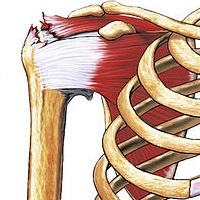
Photo from wikipedia
Partial-thickness rotator cuff tears are among the most common challenges faced by orthopaedic surgeons today. The ability to adequately manage these injuries depends on identifying their full extent during arthroscopic… Click to show full abstract
Partial-thickness rotator cuff tears are among the most common challenges faced by orthopaedic surgeons today. The ability to adequately manage these injuries depends on identifying their full extent during arthroscopic evaluation. There are many ways to fully visualize these tears, including arm positioning and gentle debridement. The purpose of this article is to highlight several tips and techniques to enable full visualization of partial-thickness rotator cuff tears to determine appropriate treatment.
Journal Title: Arthroscopy Techniques
Year Published: 2019
Link to full text (if available)
Share on Social Media: Sign Up to like & get
recommendations!